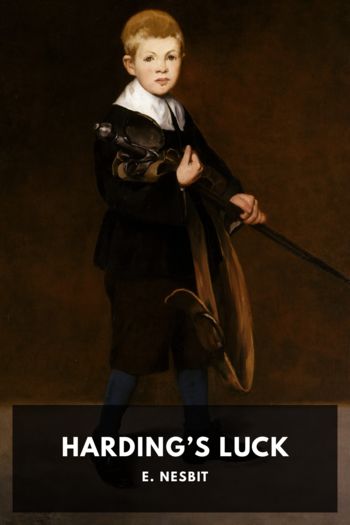The House of Arden by E. Nesbit (first ebook reader .txt) 📕

Description
Edith Nesbit was a popular children’s author of the late Victorian and early Edwardian eras in Britain. Though she was writing more than a century ago, her books nevertheless remain popular and are generally still in print.
The House of Arden was published in 1908. Like her other, perhaps better known tales, such as Five Children and It, the story takes quite ordinary children of the time and plunges them into fantastical adventures.
In this book, two children, with the interesting Saxon names of Edred and Elfrida, aged 10 and 12 respectively, discover that due to the death of a distant relative, young Edred is now Lord of Arden. The estate consists of not much more than a little money, a crumbling castle, and an attached house. An old retainer tells them of a legend regarding the Lord of Arden and a buried treasure. Naturally they are eager to locate the treasure, which may help them restore the castle. They discover a way to summon up the mascot of the House, a white mole or “mouldiwarp,” who enables them to travel back through time in search of the treasure.
Read free book «The House of Arden by E. Nesbit (first ebook reader .txt) 📕» - read online or download for free at americanlibrarybooks.com
- Author: E. Nesbit
Read book online «The House of Arden by E. Nesbit (first ebook reader .txt) 📕». Author - E. Nesbit
“Yes, dear—that’s why English people prefer Tallow kings to Stuart kings. And old Lord Arden mortgaged everything. That means he borrowed money, and if he didn’t pay back the money by a certain time he agreed to let them take the land instead. And he couldn’t pay; so they took the land—all except a bit in the village and Arden Knoll—that was fixed so that he couldn’t part from it.”
“When we get the treasure we’ll buy back the land again,” said Edred. “The Tallow King’s going to sell it. He’s got so tallowy that Arden land isn’t good enough for him. Old Beale told us. And, I say, Auntie, we’ll rebuild the castle, too, won’t we, and mend the holes in the thatch—where the rain comes in—in people’s cottages, I mean.”
“Have you been much into people’s cottages?” Aunt Edith asked anxiously—with the strange fear of infection which seems a part of a grownup’s nature.
“Everyone in the village, I think,” said Elfrida cheerfully. “Old Beale told us we ought to—in case we found the treasure—so as to know what to do. The people are such dears. I believe they like us because we’re Ardens. Or is it because Edred’s a lord?”
“We must find the treasure,” said Edred, looking as he always did when he was very much in earnest, so like his lost father that Aunt Edith could hardly bear it—“so as to be able to look after our people properly.”
“And to kick out the Tallow King,” said Elfrida.
“But you won’t be discontented if you don’t find it,” said Aunt Edith. “It’s only a sort of game really. No one I ever knew ever found a treasure. And think what we’ve found already! Arden Castle instead of Sea View Terrace—and the lodgers. Good night, chicks.”
She was gone before they were up in the morning, and the morning’s first business was the printing of the photographs.
They printed them in the kitchen, because Mrs. Honeysett was turning out the parlour, and besides the kitchen window was wide and sunny, and the old table, scoured again and again till the grain of the wood stood up in ridges, was a nice, big, clear place to stand toning dishes on. They printed on matt paper, because it seemed somehow less common, and more like a picture than the shiny kind. The printing took the whole morning, and they had only one frame. And when they had done there were eighteen brown prints of the castle from all sorts of points of the compass—north and south and—but I explained all this to you before. When the prints were dried—which, as you know, is best done by sticking them up on the windows—it became necessary to find a place to put them in. One could not gloat over them forever, though for quite a long time it seemed better to look at them again and again, and to say, “That’s how it ought to be—that’s the way we’ll have it,” than to do anything else.
Elfrida and Edred took the prints into the parlour, which was now neat as a new pin, and smelt almost too much of beeswax and turpentine, spread them on the polished oval dining-table and gloated over them.
“You can see every little bit exactly right,” said Elfrida. “They’re a little tiny bit muzzy. I expect our distance wasn’t right or something, but that only makes them look more like real pictures, and us having printed them on paper that’s too big makes it more pictury too. And anyone who knew about how buildings are built would know how to set it up. It would be like putting the bricks back into the box from the pattern inside the lid.”
Here Mrs. Honeysett called from the kitchen, “You done with all this litter?” and both children shouted “Yes!” and went on looking at the pictures. It was well that the shout was from both. If only one had done it there might have been what Mrs. Honeysett called “words” about the matter later; for next moment both said, “The films!” and rushed to the kitchen—just in time to see the kitchen fire enlivened by that peculiar crackling flare which fire and films alone can produce. Mrs. Honeysett had thrown the films on the fire with the other “litter,” and it was no one’s fault but the children’s, as Mrs. Honeysett pointed out.
“I ask you if you done with it all, an’ you says ‘Yes’—only yourselves to thank,” she repeated again and again amid their lamentations, and they had to own that she was right.
“We must take extra special care of the prints, that’s all,” said Edred, and the History of the Ardens was chosen as a hiding-place both safe and appropriate.
“It doesn’t matter so much about the films,” said Elfrida, “because we could never have shown them to anyone. If we find the treasure we’ll arrange for Auntie to find these prints—leave the History about or something—and she’ll think they’re photographs of painted pictures. So that’ll be all right.”
As they arranged the prints between the leaves of the History Elfrida’s eye was caught by the words “moat” and “water-supply,” and she read on and turned the page.
“Don’t stop to read,” said Edred, but she waved him away.
“I say, listen,” she said, turning back; and she read—
“ ‘In ancient times Arden Castle was surrounded by a moat. The original architects of the venerable pile, with that ingenuity whose fruits the thinking world so much admires in the lasting monuments of their labours, diverted from its subterraneous course a stream which rose through the chalk in the hills of the vicinity, and is said to debouch into the sea about fifty yards below high-water mark. The engineering works necessary for this triumph of mind over matter endured till 1647, when the castle was besieged by the troops of that monster in human form Oliver Cromwell. To facilitate his attack on the castle the officer in command gave orders that the stream should be





Comments (0)